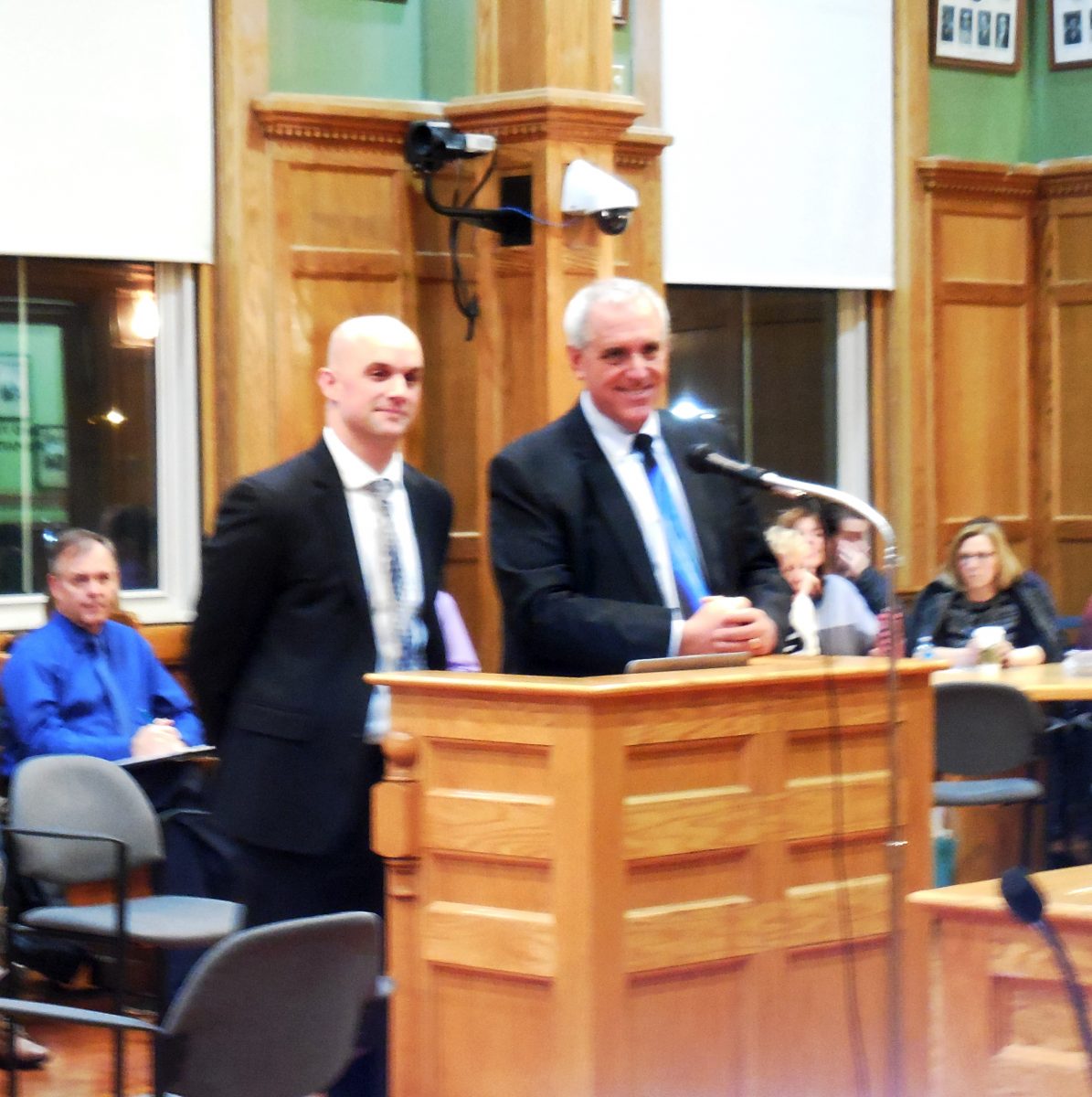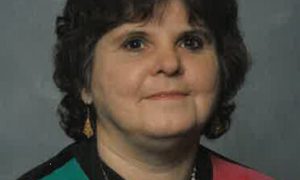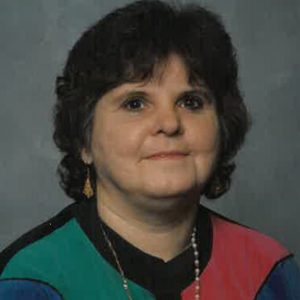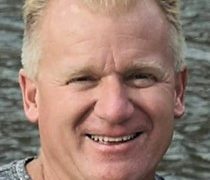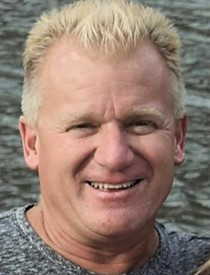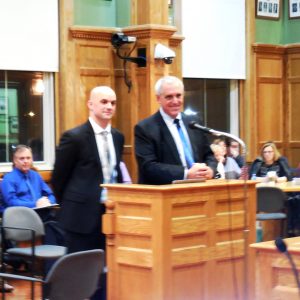
Christopher Rogers, administrator of student interventions and South Middle School principal Paul Newton gave the report for the grades 7-8 Middle School.
WESTFIELD – The transition team that has been working since September on redistricting gave presentations at Monday’s School Committee meeting on the plans for the K-4 elementary schools, the 5-6 intermediate school and the 7-8 middle school. Attendance at the meeting was largely made up of transition committee members and staff, with some parents in attendance. There will be an opportunity for public comment on the plans at a joint educational planning and curriculum sub-committee meeting on Tuesday, Feb. 27 at a location to be announced.
Westfield Public Schools Superintendent Stefan Czaporowski introduced Chief Financial Officer Ronald R, Rix and Transportation Director Pamela Kotarski to talk about the K-4 plan. Rix said they considered contracting out the redistricting of students returning from Russell Elementary, but found it to be too expensive and instead worked on it in house, with a goal of keeping it “realistic, simple and cost-effective.” He also said they were looking at a long-term solution and not a quick fix.
The first decision made by the team was to keep the Russell students together by sending all 128 to Highland Elementary School next year.
In addition, changes were made to the English language learner groups, with ELL students consolidating into two schools, Highland and Munger Hill. ELL students from Highland and Franklin (82 students) will go to Highland, and ELL students from Abner Gibbs, Munger Hill, Paper Mill and Southampton Road (58 students) to Munger Hill. Rix said there will be duplicate programs at both schools. He also said students are still arriving from Puerto Rico, so they do not know exactly how many students they will have.
Rix said they don’t expect changes in special services programs for students.
Another change will be for the 33 students living in the Mechanic Street area who will go to Abner Gibbs next year. He said the Mechanic Street students would be going to the new elementary school currently planned for Ashley Street; this way, all students in Abner Gibbs and Franklin Avenue would go to the new school when it is built.
Busing for students is also a consideration. Right now, the district has 29 buses which take three runs for the high school (A), middle schools and St. Mary’s (B) and the elementary schools (C). He said if they don’t make changes, they will need five additional buses for the B run, because 45 minutes is needed between runs. The team therefore is proposing extending the elementary school dismissal by 15 minutes, which he said would save the district $265,000. He said they are also planning to meet with St. Mary’s to discuss transportation options.
Kotarski said she will be spending the week working with a professional group to project the changes in all of the runs. The morning is not a problem, because currently there is one hour between the middle schools and elementary schools start time. “We need to finalize school times to determine transportation needs,” Rix said.
Human Resources director Paula Ceglowski said the change in elementary school dismissal time is subject to negotiations. She said she has already set up a meeting next week to discuss redistricting issues with unions.
Mayor Brian P. Sullivan said as difficult as it is on many levels, he appreciated the Russell Elementary students going as a group to Highland, and thinking ahead of the next redistricting for the new school.
Next to present were Katherine Bourque, principal of North Middle School and WPS Director of Curriculum Susan Dargie, who led the team for the grades 5-6 intermediate school, which will be housed at NMS.
“We are in the process of figuring out how to change the names of the schools. We’re trying to break the North-South thing,” Mayor Sullivan said before the presentation began.
Bourque said the working team, comprised of administrators, faculty and parent representatives met ten times. “We did spend a lot of time,” she said.
Dargie said guiding principles were meeting the needs of 10-12 year olds, and incorporating the best aspects of elementary and middle school models. She said core content areas would be separated between the grades, but integration between them would be fostered as well.
Bourque said the group contacted 16 intermediate schools and looked at best practices. They also collaborated with the 7-8 working group, and held team-building days for grades 5 & 6 staff from throughout the district.
The core program will be English language arts, math, social studies and science. An advanced math pathway will be available to grade 6 students. Electives will include health, physical education, art, music, band, chorus, digital literacy and applied technology.
An ESL intervention will be based on levels, and special education inclusion support teachers as well as program teachers. There will also be an intervention program for math and English.
The marking periods will be trimesters, which is the elementary school model. Grade 5 will also continue the standards-based grade system from elementary school, and grade 6 will have a numerical grading system.
A full range of extracurricular activities will be offered, including Student Leadership (Student Council, K-Kids, Builders Club, Ambassadors); Fine Arts (Music, Drama, Jazz Band, Art), Sports and Fitness (Intramurals, Girls on the Run); Homework Help, Robotics, Chess Club and other clubs based on student interest.
A new administrative position, Dean of Students, is being recommended in both the intermediate and middle schools. Dargie said the new position would be a Unit A member, a teacher focused on student discipline. The full report for the transitional teams will be available on the district website at www.schoolsofwestfield.org on Tuesday.
Dargie said there will be professional development for staff around the proposed changes. She said they are planning sessions over the summer and at the start of the FY19 school year.
School Committee member Ramon Diaz, Jr. asked what applied technology would entail. Dargie said there are new standards at the state level, and they will be applying those standards in both digital literacy and applied technology.
In response to several more questions about staffing and licenses, Dargie said many would be addressed at the meeting Ceglowski is having with the unions. “Overall (regarding) staffing, we don’t know yet,” Dargie said.
Christopher Rogers, administrator of student interventions and South Middle School principal Paul Newton gave the report for the grades 7-8 Middle School. Rogers said their guiding principles were to design the middle school in the best interest of grades 7-8, one that would give a wide range of learning experience to grade 7 students, and “more voice, more choice” for those in grade 8.
Grades 7 and 8 will take core academics (math, English language arts, science and social studies). Grade 7 students will also have an opportunity to take Spanish 1A or a survey of applied technology. Newton said students taking Spanish 1A, the first half of Spanish 1, could go on to Spanish 1B and receive a full credit for the class when completed. Grade 8 students could also take Spanish 1A in preparation for high school, but would not receive the credit; or they could choose to study a different language through a Learning Lab.
Newton said the applied technology overview would be four different snapshots of hands-on technology classes. All students will take physical education, health and digital literacy. Students will select band, chorus or two half-year electives of their choice. Extracurricular programs will also continue.
Another change is a proposed three days cycle of classes; the first day all eight classes in shorter, 40 minute blocks; with day 2 and 3, four 80 minute blocks each. “This is an opportunity for deeper learning,” Newton said. He said the staff is interested, and he thinks it will be “really good for kids.”
“Should we get approved for the longer blocks, the staff will need ongoing professional development,” Newton said. The school will be based on quarters and semesters, and a numerical grading system.
“I love the creativity,” said School Committee member Timothy O’Connor. “For us, it’s looking at the budget,” he added.
Czaporowski encouraged parents to study the three presentations online. School Committee Chair Kevin J. Sullivan said the February 27 sub-committee meeting will offer opportunity to ask questions about the plans.

